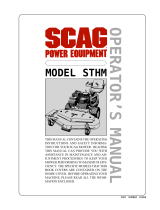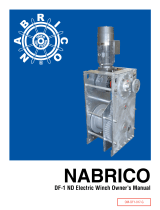Page is loading ...

CD3500 BOAT LIFT WINCH
WARNING READ INSTRUCTIONS CAREFULLY BEFORE ATTEMPTING TO INSTALL,
OPERATE OR SERVICE THIS WINCH. FAILURE TO COMPLY WITH INSTRUCTIONS COULD
RESULT IN SERIOUS OR FATAL INJURY. RETAIN THESE INSTRUCTIONS FOR FUTURE REFERENCE.
ASSEMBLY – The crank wheel and hub for this winch are not made by
Dutton-Lainson Company, so check the following to ensure trouble free
operation. The side of the hub that contacts the brake lining plate must
have a counterbore that is at least 1/8” deep before the threads begin.
Thread the crank wheel onto the drive shaft and make sure the wheel
threads on freely without any binding. Thread the wheel all the way onto
the shaft and ensure the shaft sticks out past the hub by at least 1/16”.
Install the washer and bolt onto the end of the shaft. The winch should
make a clicking noise when the crank wheel is turned clockwise. See
parts drawing for details.
IMPORTANT SAFETY INFORMATION
• This brake winch is built for raising and lowering boat lifts and other
similar applications. It is not to be used as a hoist for lifting, supporting
or transporting people, or for loads over areas where people could be
present.
• Respect this winch. High forces are created when using a winch,
creating potential safety hazards. It should be operated and maintained
in accordance with instructions. Never allow children or anyone who is
not familiar with the operation of the winch to use it. A winch accident
could result in personal injury.
• Check winch for proper operation on each use. Do not use if damaged.
Seek immediate repairs.
• Never exceed rated capacity. Excess load may cause premature failure
and could result in serious personal injury. This winch is rated to pull
1750 lbs. single line and 3500 lbs. double line on the second layer of
cable on reel. Using more layers of cable increases the load on the
winch.
• Never apply load on winch with cable fully extended. Keep at least
two full turns of cable on the reel. Check cable on every use. Replace
at first sign of kinks, broken wires, deformation or any other damage.
• Secure load properly. When winching operation is complete, do not
depend on winch alone to support load.
WINCH MOUNTING AND CABLE
ATTACHMENT – Mount the winch us-
ing two 3/8” Grade 8 bolts, washers,
lock washers, and nuts. Winch may be
mounted on either side depending on
the application. To attach cable, turn
wheel clockwise until hole in reel is ver-
tical and set screw is accessible through
hole in front of winch base. Loosen the
set screw and insert cable into hole
in reel hub. Make sure end of cable is
flush with O.D. of reel hub and tighten
set screw with 1/8” hex key. Keep three
wraps of cable on drum before applying
load.
WINCH MAINTENANCE – Keep winch in good working order. Damaged
or severely worn parts create unnecessary dangers and could result
in personal injury or property damage. The winch requires periodic
maintenance. The following check should be made at least once annually
and more frequently when the winch is exposed to an environment which
is particularly dirty or wet.
1. Remove all load from the winch so there is slack in the cable. Remove
the top cover from the winch and examine the winch gear train and
brake mechanism for any rust, corrosion, or buildup of debris which
might be present.
2. Inspect links on all roller chains and replace if there are any cracked or
missing rollers. Apply oil to roller chains with a brush or oil can. Oil each
link between the pin and bushing and the link side plates. Apply a drop
of oil at ends of bushings on intermediate sprocket assemblies and to
bushings on primary drive shaft.
CAUTION! Do not grease or oil any of the brake mechanism parts.
3. If needed, remove brake components. Remove the bolt and washer
from the end of the drive shaft and unthread the crank wheel off the
shaft by turning it counterclockwise. Remove the brake cover by
removing the three screws holding the cover to the front base plate. Pull
the ratchet pawl out of engagement with the ratchet wheel and slide the
brake lining plates and ratchet wheel off the drive shaft.
4. Check the ratchet wheel, brake lining plates, crank wheel hub and the
washer on drive shaft assembly for any build up or glaze (shiny spots)
which may be present. This can be removed by rubbing these parts
lightly with sand paper.
5. Holding tension in the ratchet pawl, reinstall the first brake lining plate,
ratchet wheel, and second brake lining plate onto the drive shaft.
Assemble the brake cover onto the winch with the three screws. Apply
a light coating of wheel bearing grease to the drive shaft threads and
thread the crank wheel onto the shaft by turning it clockwise. Install
the washer and bolt onto the end of the shaft. Make sure the winch is
making a clicking sound when turning the crank wheel clockwise.
6. Check the mounting of the winch to be sure that it is secure and check
the cable for any abnormal stiffness, kinking or broken strands. Replace
the winch cable at the first sign of damage. NOTE: Winch cable will last
longer and remain more flexible with occasional application of light oil.
The winch finish can be protected and will provide longer service if it is
washed with water and then wiped with light oil or wax.
If you have any questions whatsoever concerning the above procedure,
please contact the manufacturer.
OPERATING INSTRUCTIONS – Wind cable onto winch reel by turning
crank wheel in clockwise direction. This should produce a loud, sharp,
clicking noise. The load will remain in position when the wheel is released.
Wind cable off the winch reel by turning the wheel counterclockwise (no
noise will be produced). The load will remain in position when the wheel is
released, but for extra security it is recommended that the wheel be turned
clockwise until at least two clicks are heard. This will add extra tightness
to the brake mechanism. Always satisfy yourself that the winch is holding
the load before releasing the crank wheel.
CAUTION! Once the load has been lowered to the desired position,
continuing to wind cable off the drum may result in the cable becoming
tangled or may allow the cable to wind on the drum in the wrong direction.
Lifting a load by turning the crank wheel in the counterclockwise direction
could result in dropping the load. The brake only works when the load is
raised by turning the crank wheel in the clockwise direction.
NOT FOR MOVEMENT OF HUMAN BEINGS
MOTOR DRIVES – Operating the winch with a motor drive may result
in accelerated wear and reduced winch life. Dutton-Lainson Company is
not responsible for issues that are the result of operating the winch with a
motor drive.
WARNING! A motor drive may overpower the winch and/or cable and
could result in damage or personal injury.

Ref. Description Part No.
A Reel Assy 306292
B Spacer Shaft 406215
C Set Screw, 1/4" 206745
D Roller Chain, 54 Link 206690
E Cap Screw, 3/8 x 1 206782
F Front Base Plate 206746
G Cap Screw, 1/4 x 5 206788
H Flange Screw, 3/8 x 3/4 206779
J Hex Nut, 3/8, Brass 206784
K Brake Cover 406184
L Thread Forming Screw 206781
M Ratchet Spacer 406171
N Ratchet Spring 204363
P Ratchet Pawl 404409
Q Washer 205055
R Lock Nut, 3/8 204803
S Ratchet Wheel 404408
T Primary Shaft 306291
U Pressure Plate 205123
Ref. Description Part No.
V Bearing Support Plate 406167
W Bushing 206372
X Roll Pin, 3/16 x 1-3/8 203963
Y Sprocket 10T 406164
Z Washer, 5/8 205139
AA Bronze Flange Bushing 206686
AB Side Base Plate 406219
AC Lock Nut, 1/4 206780
AD Back Base Plate 206747
AE Spacer, Long 406178
AF Sprocket Assy, 10T, 24T 306245
AG Roller Chain, 32 Link 206689
AH Spacer, Short 406216
AJ Top Cover 406221
AK Ratchet Bolt, 3/8 206786
AL Cap Screw, 5/16 x 1/2 205118
AM Washer, 5/16 205119
AN Lock Washer, 3/8 206783
DWG. NO. 206750 3/17 ©2014 CORNHUSKER PRESS
A Dependable Company Since 1886
DUTTON-LAINSON COMPANY
Hastings, NE 68902 U.S.A. • Tel 402-462-4141 • Fax 402-460-4612
www.dutton-lainson.com • E-mail: [email protected]
MADE IN
U.S.A.
R
/





